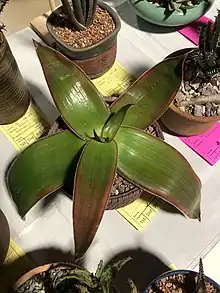Aloe fimbrialis
Aloe fimbrialis is a succulent plant species from Zambia and possibly Tanzania. A very unusual Aloe as it forms a caudex which can grow to five centimeters in diameter, the leaves grow up to ten centimeters long. The inflorescence can reach 90 centimeters in length and has coral-pink flowers. It usually grows on termite mounds. Aloe fimbrialis is a very rare aloe, first discovered in 1964 and formally described by Susan Carter Holmes in 1996[1] from a herbarium specimens. Graham Williamson rediscovered the species in 2002[2][3] on the border of Zambia and Angola, close to the source of the Zambezi River.
| Aloe fimbrialis | |
|---|---|
 | |
| Scientific classification | |
| Kingdom: | Plantae |
| Clade: | Tracheophytes |
| Clade: | Angiosperms |
| Clade: | Monocots |
| Order: | Asparagales |
| Family: | Asphodelaceae |
| Subfamily: | Asphodeloideae |
| Genus: | Aloe |
| Species: | A. fimbrialis |
| Binomial name | |
| Aloe fimbrialis | |
References
- "Aloe fimbrialis".
- "Aloes: the definitive guide". Choice Reviews Online. 49 (5): 49–2656-49-2656. 2012-01-01. doi:10.5860/choice.49-2656. ISSN 0009-4978.
- "Journal Vol 77-6". Cactus and Succulent Society of America. Retrieved 2022-12-29.
This article is issued from Wikipedia. The text is licensed under Creative Commons - Attribution - Sharealike. Additional terms may apply for the media files.